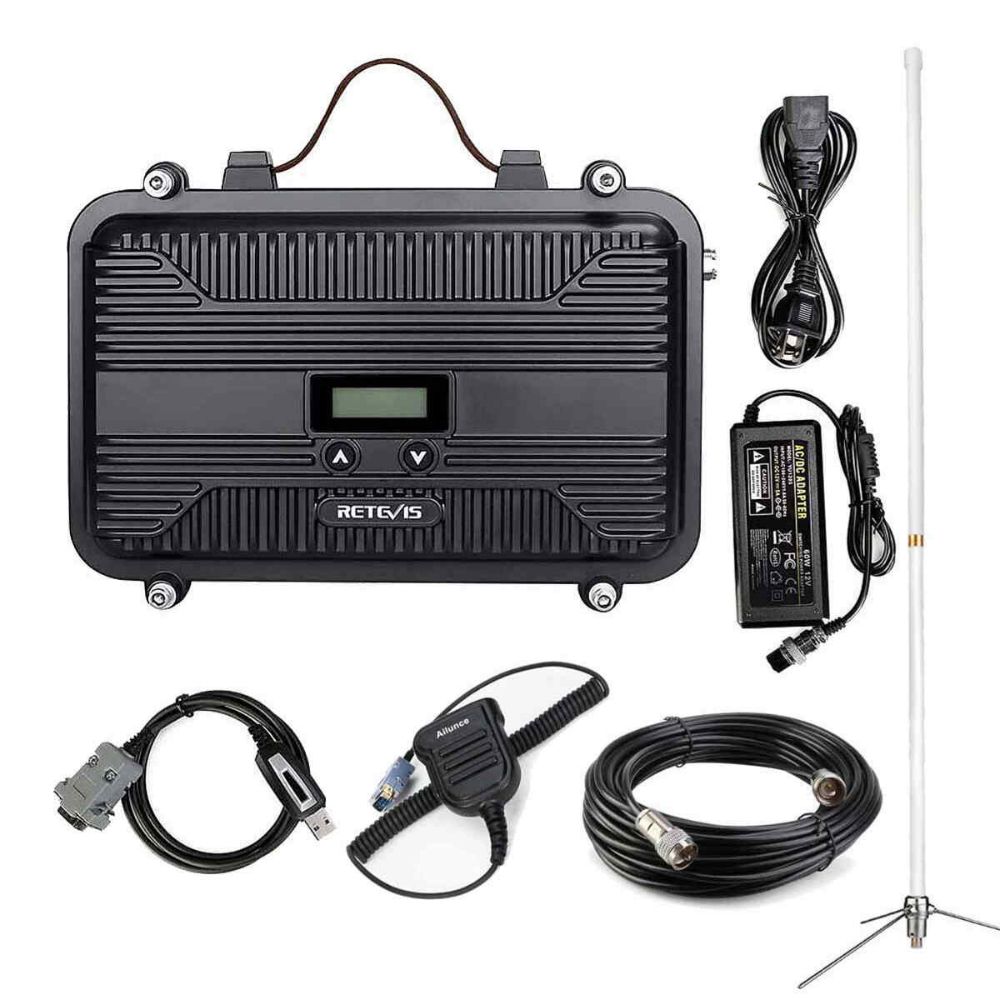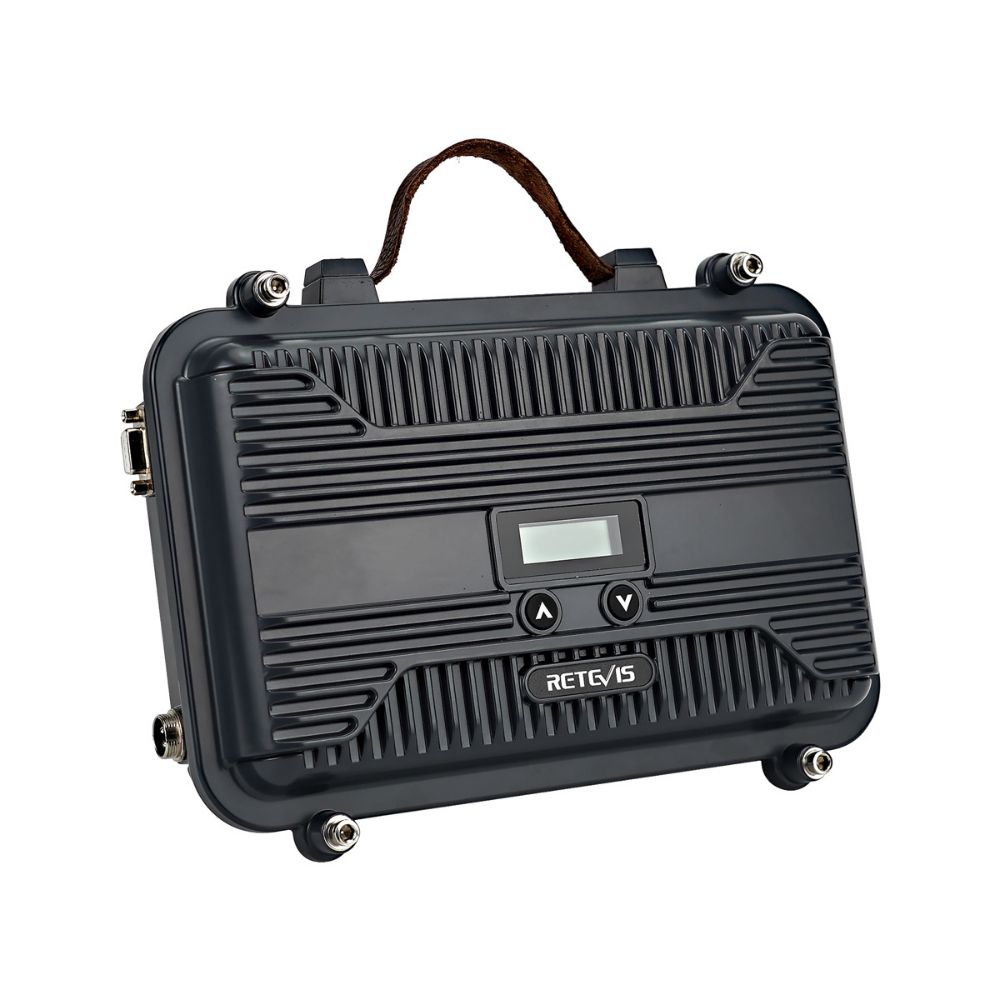- Customized Frequency
- 25W High Power
- Upgraded Feeder Cable
- Extend the Distance
- Customizable Range: [UHF: 400-470MHz or VHF: 136-174MHz; Offset ≥5MHz and ≤12MHz]; Frequencies Should be Programmed within ±200 kHz
Ham Radio Repeater
Pre-order the 50W Repeater for Just $1
$1 pre-order fee is fully refundable at any time
200 pre-orders by April 19th will trigger the start of development and production in June 2025
Pre-order customers will receive priority access, priority shipping, and exclusive purchase discounts
Pre-order Now and Let Us Know Your Interest!
NOTE:
- Please note the customized information when placing an order.
- After confirming your custom frequency, it will take 4 weeks to customize.
- After customization, the frequency is fixed and cannot be returned.
- Upgraded duplexer
25W high power
Portable design
IP66 waterproof - Upgraded Feeder Cable
- Easy installation, plug and play
- Frequency Range: 462.550-462.725 MHz (TX) 467.550-467.725 MHz (RX)
- RT97L GMRS Repeater Kit comes with everything you need to setup and use
-
Order before 20-Apr-2025 → Tariffs GUARANTEED Covered!
- Customized Frequency
- 25W High-Power
- IP66 Waterproof
- Connect to Raspberry Pi to extend the signal
- Customizable Range: [UHF: 400-470MHz or VHF: 136-174MHz; Offset ≥5MHz and ≤12MHz]; Frequencies Should be Programmed within ±200 kHz
NOTE:
- Please note the customized information when placing an order.
- After confirming your custom frequency, it will take 4 weeks to customize.
- After customization, the frequency is fixed and cannot be returned.
- 3M Coaxial Cable: Using a 3-meter coaxial cable, the repeater and antenna are installed in close proximity, minimizing feeder loss and maximizing transmission power.
- Extend the Distance: RT97S GMRS repeater helps to connect emergency calls outside the range of the walkie talkies; and is suitable for outdoor activities, such as large-scale farms, remote mountainous areas, towns communications; etc.
- Simplified Installation with Duplexer: The built-in duplexer allows for signal transfer using just one antenna, simplifying the installation process. Keep in mind the potential power loss associated with the duplexer.
- Compact and Portable Design: RT97S portable repeater is lightweight and easy to transport. This makes it quite convenient for users who need to set up and relocate their repeater frequently.
- DB-9 Female Connector: The RT97S base station can be directly connected to a mic and is compatible with Raspberry Pi.
- Long-Range Coverage :The RT97P’s 10W UHF repeater extends the HD2’s range to over 20 miles of communication in dense forests or mountainous areas. Perfect for coordinating search and rescue teams during forest rescues where line of sight is obstructed.
- GPS functionality:The HD2’s GPS functionality allows for location tracking of team members. allowing first responders to effectively coordinate with their teammates in critical situations.
- Convenient and fast:RT97P's portable design (2.2 pounds) can be set up in less than 5 minutes, making it ideal for outdoor use, and HD2's IP67 waterproof rating and ruggedness ensure it works even in extreme weather
- Secure large-team management:HD2’s 3000 channels, 32 group IDs, 500,000 contact capacity allow multiple teams (such as rescue and medical) to communicate simultaneously without confusion, maintaining cross-group interoperability.AES-256 encryption effectively provides secure communications.
- All-in-one emergency coordination solution: The kit combines GPS tracking, DMR radio clarity, and repeater functions to simplify rescue workflows. It supports multi-team collaboration and effectively improves rescuers' communication efficiency
- DMR repeater set: 6 X HD2 GPS DMR radio, 1 X RT97P repeater kit
- Rugged Mountain & Valley Communication
The RT97S repeater extends signals across hills and valleys, paired with HA1G’s 5W power and IP67 waterproofing—ideal for mountain biking races or forest treks. - Marathon & Large Event Coordination
With 8 repeater channels and HA1G’s 256 customizable channels, this bundle ensures seamless communication for marathons or multi-team events in hilly terrain. - Weatherproof Durability
HA1G’s IP67 rating and RT97S’s water-resistant design survive heavy rain, perfect for multi-day bike races or emergency ops in harsh conditions. - Rugged & Reliable
Both the RT97S and HA1G feature rugged housings to withstand harsh mountain terrain, while the 5W of power ensures a clear signal across the valleys - perfect for bike races or outdoor activities in the valleys.
- Rugged Mountain & Valley Communication
The RT97S repeater extends signals across hills and valleys, paired with HA1G’s 5W power and IP67 waterproofing—ideal for mountain biking races or forest treks. - Marathon & Large Event Coordination
With 8 repeater channels and HA1G’s 256 customizable channels, this bundle ensures seamless communication for marathons or multi-team events in hilly terrain. - Weatherproof Durability
HA1G’s IP67 rating and RT97S’s water-resistant design survive heavy rain, perfect for multi-day bike races or emergency ops in harsh conditions. - Rugged & Reliable
Both the RT97S and HA1G feature rugged housings to withstand harsh mountain terrain, while the 5W of power ensures a clear signal across the valleys - perfect for bike races or outdoor activities in the valleys.
NOTE:
- Please note the customized information when placing an order.
- After confirming your custom frequency, it will take 4 weeks to customize.
- After customization, the frequency is fixed and cannot be returned.
*A repeater consisting of two RA87 40W GMRS mobile radios
*467.5500~467.7250, 8 GMRS relay channels
*Built-in linear regulated power supply, stable and reliable
Support CHIRP programming
 Fast Shipping from the USA, Save USD20 When Checkout
Fast Shipping from the USA, Save USD20 When Checkout
- 5W repeater+Two RA86 20W mobile radio
- Large farm communication equipment
- Suitable for communication in large farms, pastures, warehouses and other large venues.
- 467.5500~467.7250, 8 GMRS Repeater Channel
- 40W High Power and Long Range
- Handheld Microphone, also Base Station
- Built-in linear regulated power supply, stable and reliable.
- Support CHIRP programming
- Note: Duplexer is not included, there are no restrictions on receiving and transmitting frequency points, and dual antennas are required.
- DB-9 Female Connector: RT97S base station can be directly connected to a mic and is compatible with Raspberry Pi.
- Compact and Portable Design: RT97S mini repeater can serve as a vehicle transceiver substitute and can be easily mounted on roofs or in mountainous areas to effectively relay signals.
- Extend the Distance: RT97S GMRS repeater helps to connect emergency calls outside the range of the walkie talkies; and is suitable for outdoor activities, such as large-scale farms, remote mountainous areas, towns communications; etc.
- User-Friendly Interface: Featuring 8 GMRS channels, a vibrant color LCD display, and intuitive buttons, you can quickly select different relay channels for seamless communication.
- Energy Efficient Design: The RT97S two way radio repeater is perfect for solar-powered repeater installations, requiring low power and occupying minimal space.
- Extend the Distance: RT97S GMRS repeater helps to connect emergency calls outside the range of the walkie talkies; and is suitable for outdoor activities, such as large-scale farms, remote mountainous areas, towns communications; etc.
- Upgraded Feeder Cable: This set includes an upgraded feeder cable, which can reduce 1-2W power loss. The new cable's size is φ10.62mm, much larger than the previous φ4.88mm.
- Simplified Installation with Duplexer: The built-in duplexer allows for signal transfer using just one antenna, simplifying the installation process. Keep in mind the potential power loss associated with the duplexer.
- Compact and Portable Design: RT97S portable repeater is lightweight and easy to transport. This makes it quite convenient for users who need to set up and relocate their repeater frequently.
- DB-9 Female Connector: The RT97S base station can be directly connected to a mic and is compatible with Raspberry Pi.
- Customized: The duplexer has a very narrow operating frequency band, Now allowing to customize the Repeater according to your TX and RX frequency.
- Built-in Sound Card: Exchange data with Raspberry Pi(not include) via DB9 connector
- Easy installation: built-in duplexer, volume is only 10.2*8.3*2.8in, weight is only 3.7ibl
- Multiple power supply methods: powered by DC12V~24V power (car power and solar battery), and AC220V power
- Best system performance: RT97S is dustproof and waterproof, and can be directly installed near the antenna to minimize the loss of the feeder.
NOTE:
- Please note the customized information when placing an order.
- After confirming your custom frequency, it will take 2 weeks to customize.
- After customization, the frequency is fixed and cannot be returned.
- This product does not include a cable to connect to the Raspberry Pi.
- 8 GMRS Repeater Channels
- Built-in sound card can be connected to Raspberry Pi
- Antenna and extender cable can boost the repeater's signal
Directly shipped from US warehouse
- GMRS Frequencies: Support the 8 FCC assigned GMRS repeater channels as well
- Built-in Sound Card: Exchange data with Raspberry Pi(not include) via DB9 connector
- Easy installation: built-in duplexer, volume is only 10.2*8.3*2.8in, weight is only 3.7ibl
- Multiple power supply methods: powered by DC12V~24V power (car power and solar battery), and AC120V power
- Best system performance: RT97S is dustproof and waterproof, and can be directly installed near the antenna to minimize the loss of the feeder.
Flexible IP networking: The device is connected in an IP interconnection mode, and supports wired access mode or wireless access modes such as WIFI, 3G/4G, and satellite communication to implement voice and data communication.
- 10W DMR Portable Repeater
- Analog and Digital Mode
- Extend the distance of the handheld Radios
- TX frequency and RX frequency can be customized
- Can be powered by DC12V~24V power, car power and solar battery
NOTE:
- Please note the customized information when placing an order.
- After confirming your custom frequency, it will take 4 weeks to customize.
- After customization, the frequency is fixed and cannot be returned.
- 10W DMR Portable Repeater
- Analog and Digital Mode
- Extend the distance of the handheld Radios
- Exceptional Clear Voice Quality
- Can be powered by DC12V~24V power, car power and solar battery
NOTE:
- UHF-10mhz-Stock: Offset 10mhz, TX: 463.3125mhz and RX: 453.3125MHZ
- Programming software: please click "ServiceSupport" to download.
- 10W DMR Portable Repeater
- Analog and Digital Mode
- Extend the distance of the handheld Radios
- Exceptional Clear Voice Quality
- Can be powered by DC12V~24V power, car power and solar battery
NOTE:
- VHF-10mHz-Stock: Offset 10mhz, Tx:162.6125mhz and RX:152.6125MHZ.
- Programming software: please click "ServiceSupport" to download.
Portable Repeater to swiftly provide on-scene portable radio coverage. Cast aluminum shell, durable, moisture-proof and dust-proof. The lightweight suitcase is ideal for discreet travel.
Retevis portable repeaters for use in Search & Rescue, wildland fire, remote camps, remote mining,.
What does a ham repeater do?
An amateur radio repeater is an electronic device that receives a weak or low-level amateur radio signal and retransmits it at a higher level or higher power, so that the signal can cover longer distances without degradation. Many repeaters are located on hilltops or on tall buildings as the higher location increases their coverage area, sometimes referred to as the radio horizon, or "footprint". Amateur radio repeaters are similar in concept to those used by public safety entities (police, fire department, etc.), businesses, government, military, and more. Amateur radio repeaters may even use commercially packaged repeater systems that have been adjusted to operate within amateur radio frequency bands, but more often amateur repeaters are assembled from receivers, transmitters, controllers, power supplies, antennas, and other components, from various sources.
More hams use frequency-modulated (FM) voice than any other communications mode. Most hams have an FM rig of some type. They use it to keep in touch with their local friends. Generally, it's a good idea to use VHF or UHF for all local communications. The HF bands should be reserved for longer-distance contacts to reduce interference on the HF bands.
The communications range for VHF and UHF FM simplex is usually limited to your local area (5-15 miles). If you live high on a mountain and use a high-gain directional antenna, you may be able to extend your range considerably. Unfortunately, most of us do not have the luxury of ideal VHF/UHF operating conditions. Often, we want to make contacts even though we live in a valley, are driving in a car or are using a low-power, hand-held transceiver.
Enter repeaters. A repeater receives a signal and re-transmits it, usually with higher power and from a better location, to provide a greater communications range. Often located atop a tall building or high mountain, VHF and UHF repeaters greatly extend the operating range of amateurs using mobile and hand-held transceivers. If a repeater serves an area, it's not necessary for everyone to live on a hilltop. You only have to be able to hear the repeater's transmitter and reach the repeater's receiver with your transmitted signal.


























